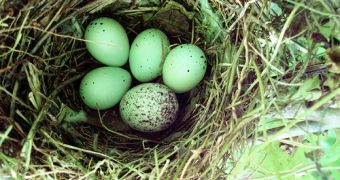The way birds are able to distinguish between their own eggs and those of parasitic layers such as cuckoos has kept scientists mystified for a long period. At the same time, everybody seemed to have forgotten that birds are able to see much more differently than us and that their eyes are, in fact, capable of observing quite a big chunk of the ultraviolet spectrum, which is invisible to us. Only when researchers started thinking about how UV light is reflected, a connection started to appear between birds' ability to distinguish between their eggs and those of others, and their unique sight capabilities.
To put the theory to the test, Marcel Honza of the Academy of Sciences of the Czech Republic designed an experiment to see whether or not a blackcap would evict an egg that reflects light in the UV spectrum differently than that of its own. However, instead of using cuckoo eggs, the team took abandoned blackcap eggs and painted them in a UV blocker before placing them in a nest with Vaseline coated blackcap eggs. Vaseline does not alter the reflectivity of eggs in the UV spectrum; thus, they appeared exactly as natural blackcap eggs in the UV wavelengths.
After five days, the researchers checked to see how many of the Vaseline eggs were still in the nest, in comparison with the ones that had been coated with the UV blocker. Only 11 of the original 16 Vaseline coated eggs remained in the nest, while nearly one third of all the blackcaps participating in the test ejected the UV blocking eggs, the remaining ones accepting the parasitic eggs although having a different appearance.
Since the experiment showed that blackcaps ejected far more eggs coated with the UV blocker than those coated with Vaseline, it reveals that the UV appearance of an egg is a key factor in determining whether it belongs to a parasitic layer or to a bird of the same species or not. The next step, Honza says, is to establish whether cuckoos use this feature to lay their eggs in nests having eggs with UV reflectivity similar to their own.

 14 DAY TRIAL //
14 DAY TRIAL //